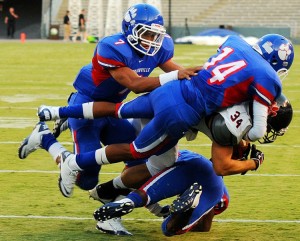Concussions are a big topic of discussion in the world of sports, in particular in the sport of football. Statistics show that there are between an estimated 1.6 and 3.8 million sports-related concussions in the United States every year, and athletes ages 16 to 19 sustain 29% of all sports-related concussions.
There are distinct differences in age when it comes to managing sport related concussions. Recent research demonstrates that high school athletes not only take longer to recover after a concussion when compared to collegiate or professional athletes, but they also may experience greater severity of symptoms and more neurological disturbances as measured by neuropsychological and postural stability tests. It is also estimated that 53% of high school athletes have sustained a concussion before participation in high school sports, and 36% of collegiate athletes have a history of multiple concussions. [2]
To better understand the impact of a hit that a football player receives on the field (which often leads to other serious injuries), Jake Merrell, a Brigham Young University (BYU) graduate student in mechanical engineering, has developed a “smart foam” that fits inside of a football helmet.
“Smart Foam” – An Impact Detection System and Alert System for Coaches
 While searching for a way to measure the amount of impact inside a football helmet, Merrell discovered that when he combined nanoparticles to a foam substance similar to that found inside a football helmet, when compressed, the two created an electric current. The “Smart Foam” system is a combination of foam and motion sensors that measures the acceleration and force of impact that a player receives to his head, and transmits that data to a tablet or computer. It also sends a warning to sideline coaches that there has been a concussion-level hit. In a recent press statement Merrell stated, “A coach will know within seconds exactly how hard their player just got hit. Even if a player pops up and acts fine, the folks on the sidelines will have data showing that maybe he isn’t OK.” [3] Merrell has plans to submit his project to the Head Health Challenge in which the “NFL is collaborating with G.E. and Under Armour to spend $60 million researching and developing new helmet technologies.” [4]
While searching for a way to measure the amount of impact inside a football helmet, Merrell discovered that when he combined nanoparticles to a foam substance similar to that found inside a football helmet, when compressed, the two created an electric current. The “Smart Foam” system is a combination of foam and motion sensors that measures the acceleration and force of impact that a player receives to his head, and transmits that data to a tablet or computer. It also sends a warning to sideline coaches that there has been a concussion-level hit. In a recent press statement Merrell stated, “A coach will know within seconds exactly how hard their player just got hit. Even if a player pops up and acts fine, the folks on the sidelines will have data showing that maybe he isn’t OK.” [3] Merrell has plans to submit his project to the Head Health Challenge in which the “NFL is collaborating with G.E. and Under Armour to spend $60 million researching and developing new helmet technologies.” [4]
Other Systems Prove Incompatible with the “Smart Foam” System
Riddell, the manufacturer of football helmets, introduced a similar concussion-alert product this year, called the InSite Impact Response System, which is currently being used by some high school teams. The drawback with Riddell’s system, however, is that it only works in the Riddell’s Revolution Speed helmet and has not proven to be 100 percent effective. In fact, a study from the University of Wisconsin shows that no brand is actually succeeding in reducing the risks of concussions.
The NFL and helmet makers have recently thrown more resources at investigating concussions, but current technology only provides data through bulky accelerometers in the crown of a helmet. Merrell’s piezoelectric foam accounts for both force and acceleration to measure actual impact.
Already, Merrell’s research on the nano-foam has landed him and his mentors National Science Foundation funding, as well as a top paper award at an American Society of Mechanical Engineers conference.
Beyond football, Merrell hopes his piezoelectric self-sensing foam is able to transform any foam into an impact sensor for a wide range of applications, from law enforcement to the automotive industry. [5]
 Merrell and his colleagues – Professors David Fullwood, Anton Bowden and undergraduate research assistants Parker Rosquist, Brady Anderson, Adam Bilodeau – are planning to sell the finished product for under $300, which Merrell said is lower than comparable systems that generally rely on accelerometers. They are also exploring other uses of the “smart foam” such as measuring footfall impact in shoes and reconstructing car crashes.
Merrell and his colleagues – Professors David Fullwood, Anton Bowden and undergraduate research assistants Parker Rosquist, Brady Anderson, Adam Bilodeau – are planning to sell the finished product for under $300, which Merrell said is lower than comparable systems that generally rely on accelerometers. They are also exploring other uses of the “smart foam” such as measuring footfall impact in shoes and reconstructing car crashes.
About Keith L. Brown
Keith L. Brown is a convert to The Church of Jesus Christ of Latter-day Saints, having been born and raised Baptist. He was studying to be a Baptist minister at the time of his conversion to the LDS faith. He was baptized on 10 March 1998 in Reykjavik, Iceland while serving on active duty in the United States Navy in Keflavic, Iceland. He currently serves as the First Assistant to the High Priest Group for the Annapolis, Maryland Ward. He is a 30-year honorably retired United States Navy Veteran.



